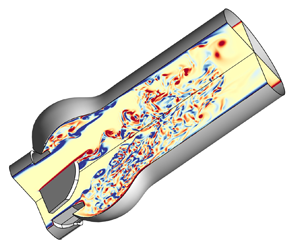Article contents
Numerical investigation of turbulent features past different mechanical aortic valves
Published online by Cambridge University Press: 19 April 2022
Abstract

Flow through mechanical aortic valves (MAVs) has been constantly associated to higher haemolysis and platelet activation levels with respect to native valves, due to non-physiologic haemodynamic features. Both computational and experimental investigations have correlated the blood damage to augmented levels of turbulent stress downstream of MAVs. This study provides a computational estimation, drawn from high-resolution direct numerical simulations, of turbulent and fluctuating viscous stresses in three different MAV configurations, at subsequent stages of the cardiac cycle. The configurations comprise a St. Judes Medical Regent valve (SJMV), a Lapeyre-Triflo FURTIVA valve (LTFV) with three leaflets, and a SJMV with vortex generators (VGs). Non-standard configurations are expected to mitigate the mean stress level on blood constituents reducing the turbulent production. Computations are carried out by means of a finite-difference flow solver with a direct-forcing immersed boundary technique to handle fixed and moving bodies. The VGs are found to provide instabilities which corrupt the Kármán-like vortex shedding downstream of the leaflets, reducing the intensity of turbulent kinetic energy at the peak flow rate, thus lowering the local Reynolds shear stress. Conversely, the LTFV configuration provides comparable haemodynamic performance at peak flow rate but further reduced stress level in the deceleration phase. These interpretations are supported by probability density distributions from three-dimensional fields, and further corroborated by a pointwise mapping of the Taylor length scale and local energy spectra. The outcomes of this study might potentially be exploited to improve the design of new-generation MAVs, with the aim of decreasing the risk of thromboembolic complications.
Information
- Type
- JFM Papers
- Information
- Copyright
- © The Author(s), 2022. Published by Cambridge University Press
References
REFERENCES
- 12
- Cited by


